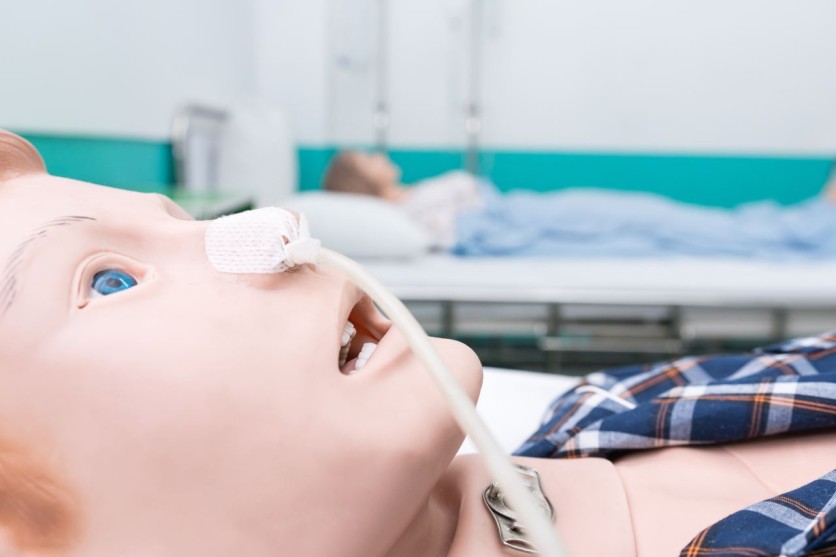
How to Assess the Safe Placement of a Nasogastric Feeding Tube
Considering lung collapse (pneumothorax) affects 2-5% of 35 million feeding tube placements every year worldwide, the safe placement of a nasogastric feeding tube requires special medical care. Reducing the chance of pneumothorax and aspiration pneumonia for patients requiring enteral feeding is made possible by increasing awareness of common complications and understanding technologies that help with such procedures.
If proper nutrition or medication cannot be delivered to patients via the regular oral route, the safe placement of a nasogastric feeding tube is essential. In addition, it is used to prevent dehydration and malnutrition in surgical and critically ill patients who ordinarily cannot receive nutrition due to medical situations, such as mechanical ventilation in an ICU or post-major surgery complications. Children born prematurely may also need care involving the safe placement of a nasogastric feeding tube.
Feeding tube placement is a common procedure that is carried out daily across the globe. Therefore, it is essential to understand the complications associated with feeding tube misplacement and how to reduce them. Complications include lung collapse (pneumothorax), aspiration pneumonia, nasopharyngitis, epistaxis, and sinusitis. Understanding these potential challenges can help hospital staff utilize readily available technologies and safe practices to ensure proper tube placement.
The most common placement technique is blind insertion, in which the medical staff inserts the feeding tube from the nose and down the esophagus to the stomach without any guidance.
Blind placement may lead to common complications like pneumothorax and aspiration pneumonia.
To address these significant safety concerns, ENvizion Medical launched ENvue, an FDA-cleared electromagnetic body mapping technology, to market.
Using a state-of-the-art navigation system allows healthcare professionals to place feeding tubes accurately and safely.
Feeding Tube Placement Complications to Consider
There are several potential complications associated with nasogastric feeding. The most common are discomfort, nausea, and coughing. More severe complications like lung collapse (pneumothorax) are associated with many injuries and deaths due to tube misplacement, with the majority occurring due to a tube entering the pulmonary system.
Indications of an incorrectly positioned nasal gastric feeding tube include lung aspiration, respiratory distress, tachypnea, and pneumonia.
Because of the challenges surrounding the placement of a nasogastric tube, safety practices, and technologies have been created to assist with the accuracy and confirmation of tube location.
Placement Confirmation Methods
There are several methods to confirm positioning:
X-ray (radiograph) - After inserting a feeding tube, a radiograph can be used to verify its final location. Although radiographic verification is the gold standard, it may show lung placement only after the damage has occurred. Moreover, radiographic confirmation is associated with additional technical and personnel costs, possible delay of feedings, and an increased risk of radiation exposure. The longer a feeding tube remains in the incorrect position, the more damage it will likely cause the patient.
Auscultation (listening to the body with a stethoscope) - This was a method once commonly used to ensure nasogastric feeding tubes were placed correctly. Dr. Malcom Lemzye (2010) explains in his research that "auscultation may not differentiate between respiratory and gastrointestinal placement of a nasogastric tube," therefore being questioned today for accuracy. The sound through the stethoscope may be mistaken for proper placement, as the same sound is sometimes heard when incorrectly placed into a patient's tracheobronchial tree, pleural space, or esophagus.
Measuring the pH level of a feeding tube can also be utilized to ensure correct placement. Although a pH value of less than 5.0 may indicate gastric placement, the measuring method is limited when gastric reflux arises, leading to potential inaccuracy. Other drawbacks include difficulty obtaining aspirates and possible inconsistencies related to the use of acid-reducing drugs and recent ingestion of enteral food or formula.
Another new method used for feeding tube placement confirmation is ultrasound. However, in 2017, a systematic Cochrane Review carried out ten studies, later disclosing that the ultrasound did not have adequate precision as a standalone test to confirm tube placement. The study concludes that additional research is needed to identify potential adverse effects.
The Future of Safe Placement
In recent years, ENvizion Medical developed a unique solution for reducing complications during the placement of nasogastric tubes, further decreasing the need for repeated X-ray confirmation and other outdated methods.
The ENvue® feeding tube navigation system assists professionals in accurately and safely placing feeding tubes quickly while avoiding unwanted incidents and risks. Using electromagnetic technology, the system allows clinicians to observe a tube placement in real-time and alerts when the feeding tube potentially deviates, heading toward the bronchial airways.
The ENvue System is commercially available in the US and easily adoptable by hospitals. ENvizion Medical is a publicly traded global MedTech company, and its ENvue product has been cleared by FDA 510(k) since February 2019.
Patient Safety Remains Top Priority
Patient safety always remains the top priority of healthcare. However, due to some limitations, the existing methods of nasogastric tube placement can present potential complications and risks. For example, in a report querying the Pennsylvania Patient Safety Reporting System, the NGT guideline-approved methods X-ray and pH aspirate were recognized in 90.8% (544 of 599) of the reports. However, in 9.2% (55 of 599) of the reports, non-recommended verification methods, such as auscultation, were used. This demonstrates the need for access to specialized technologies like the ENvue system.
Medical professionals must stay aware of the latest practices and devices, considering the importance of patient safety. The information in this article highlighted trends in global patient care and how to prevent more avoidable complications and deaths in the future.
ⓒ 2025 TECHTIMES.com All rights reserved. Do not reproduce without permission.




